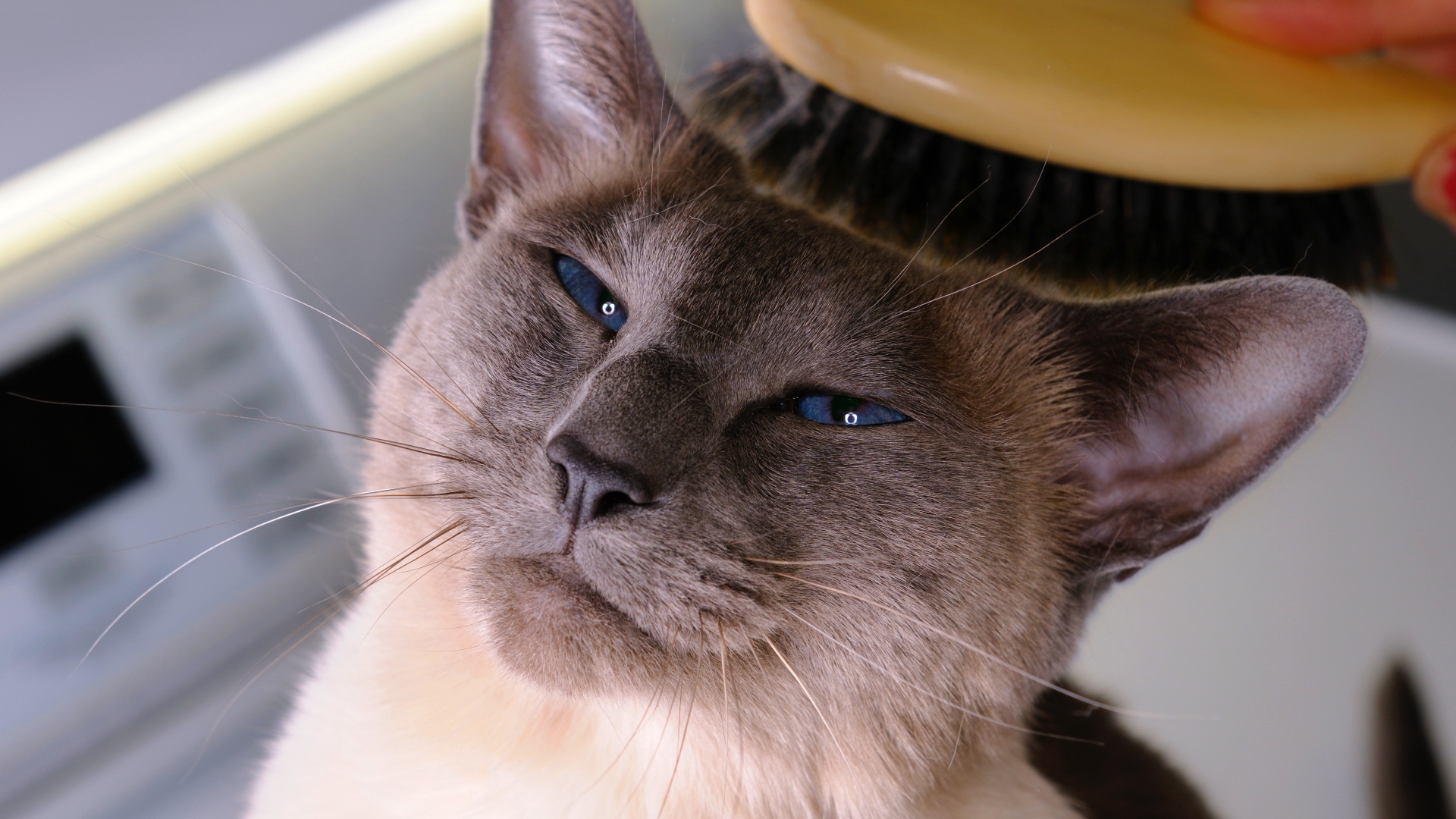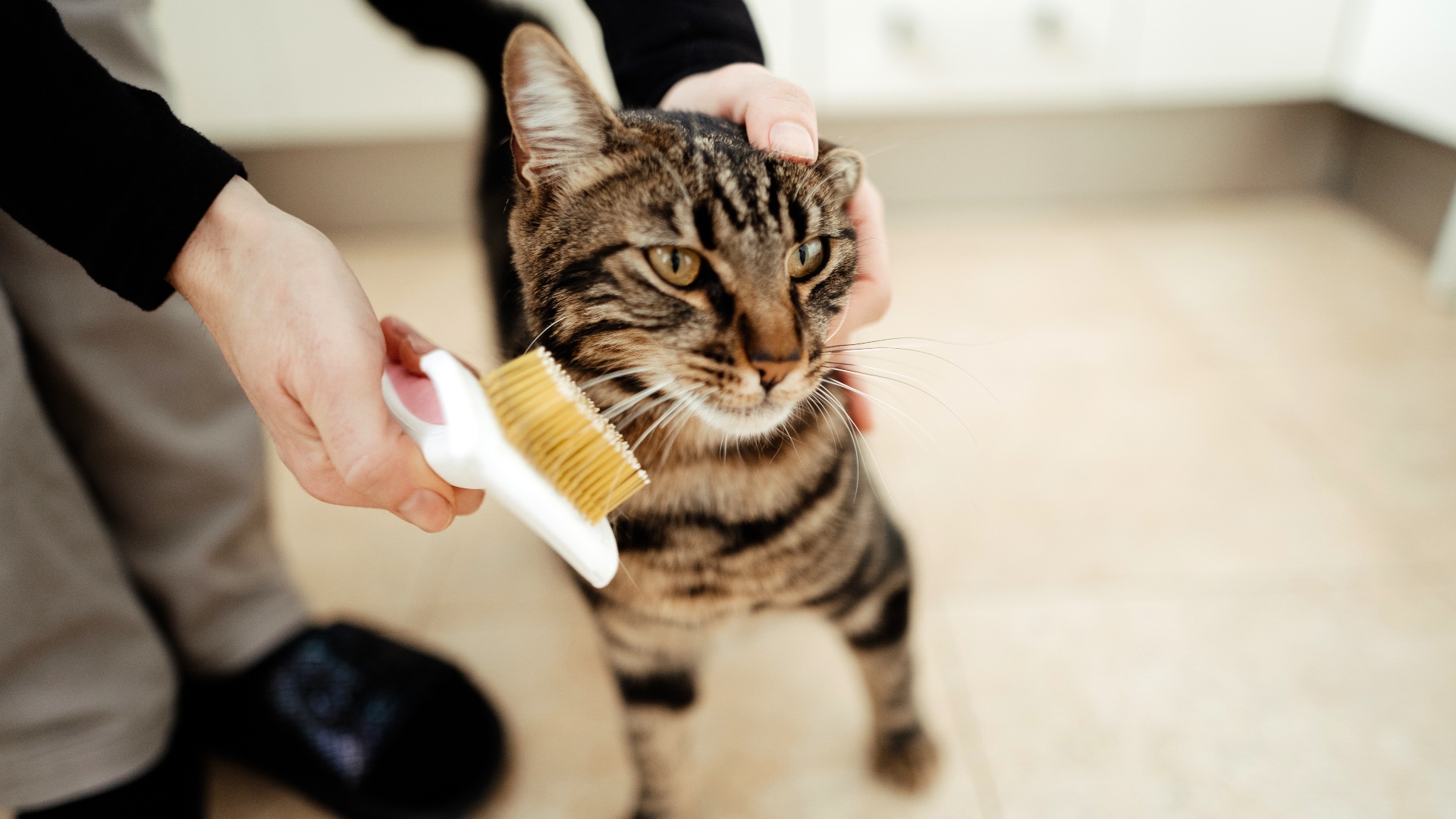Brushing cats: Top tips to keep your kitty’s skin and fur in purr-fect health
The benefits and techniques for brushing cats from short-haired and long-haired to those that don't want to be brushed

The idea of brushing cats may seem rather unnecessary given the amount of time your kitty probably spends grooming themselves. However, brushing your feline friend has numerous benefits, both for the health and cleanliness of your kitty and in helping you to build a stronger emotional bond with them. A few sessions each week will give them a tangle-free life and a closer relationship with you.
But how exactly should you go about brushing your cat and what do you do if you have a feline furkid who can’t stand you grooming them? Let’s find out!
The benefits of brushing your cat
Brushing your cat regularly will help keep their coat and skin healthy. Sure, they may be grooming themselves all the time, but that rough tongue needs a helping hand in removing tougher tangles and excess hair. Using one of the best cat brushes also helps to remove dirt, dandruff, skin flakes, and grease from their fur and skin. The action of brushing also helps stimulate blood circulation in the epidermis, making their hair glow and helping to encourage better skin health.
If your cat is a big shedder, brushing sessions help you get all that loose hair collected on the brush, rather than it coating the carpet, curtains, and other soft furnishings. The brush will remove all the dead hair leaving your cat sleeker and less able to leave a fur trail guaranteed to bung up your vacuum cleaner. It also reduces the number of hairballs your cat will be producing as the excess fur will have already been collected. A few hairballs are natural, but they aren't much fun to tread on barefoot!
Brushing is especially beneficial if you have an older cat, as it will ensure they are still getting the full-body grooming they need. As your furry friend ages, they become less flexible and this reduces their ability to groom properly by themselves. Helping them out with a brush will keep their hair and skin in top form in the areas they can no longer reach.
And we've saved the best benefit until last: as mentioned above brushing helps you bond with your cat. If you have more than one cat in the house you may have seen them grooming each other – this is called allogrooming and is how cats show each other affection and trust. By grooming them with a brush you are showing your cat you consider them part of your family, and this, in turn, will lead to them loving you more.
What to do before brushing your cat
It's best to carry out a body check on your cat before you start brushing them. This will prevent you from accidentally hurting your cat by brushing sensitive areas and will help you spot any common skin ailments your furry friend may be suffering from. Hair and skin health is also a good indicator of your kitty's overall condition.
Get the best advice, tips and top tech for your beloved Pets
Healthy cat hair will seem glossy and spring back when you smooth it down. Check for bald patches or signs of fleas and ticks, and ensure their skin is free of wounds or unusual bumps. If everything seems fine, it's time to start grooming your cat. If not, a vet appointment should be your next port of call.
Tips for the first time brushing your cat

You want your cat to be comfortable and happy during the grooming process. Brushing should never be forced - you want your cat to feel they can move away at any time. This means you should never hold down your cat to brush them as your cat will see this as a sign of aggression and will be likely to feel trapped and stressed.
Wait until they are receptive to being stroked then introduce the brush or comb. Start by only gently grooming the areas they like to be petted – usually down the back, between their ears, or under the chin. Take your time, cats like to feel they are in control and if you rush it, they will feel they are being dominated and leave.
As they get used to you grooming these areas you can start to venture to more sensitive areas like the stomach. At any sign of discomfort from your furry friend, go back to the safe areas so they understand this is meant to be nice and you will respond to their complaints. As they get more used to grooming on their terms and have built up more trust they will let you go into these areas without growling or biting.
Matts and tangles should only be tackled if they are loose and easy to brush out. If they are large or strongly matted it's better to have a grooming professional deal with these, otherwise, you pulling and tugging at them may put your cat off the brushing experience for a long time.
Once you've finished the brushing session give them a few of the best cat treat so that they recognize that this is a rewarding experience. Try to do this a couple of times a week and you'll soon be bonding strongly with a glossy, clean cat with great skin!
How to brush a short-haired cat
Gently run a metal flea comb or pin brush over your cat's fur to get rid of dirt and debris and to check for fleas. If you do find any signs of an infestation, give them an all-over comb to remove the worst of them, and then book them in to a vet to get some flea medication to treat them.
If they are flea-free, you are ready to start with a rubber or bristle brush. Most cats do well with a dual-sided brush that has a soft “bristle” side, and a fine “pin brush” side that is used for dealing with tangles and mats.
Concentrate on one section at a time to ensure you are removing all the dead hair and massaging their skin thoroughly. Always be gentle, so do not pull at matts or tangles, but gently tease them out. Cats with large tangles, say one that hasn't been groomed for a while, may do well with a visit to a professional groomer first, and then you can keep them tangle-free yourself after that.
How to brush a long-haired cat
Long-haired cats need more brushing than short-haired cats, and to keep on top of those potential matts and tangles that can mean grooming them once a day, depending on their lifestyle. They also shed all year round, so preventing a build-up of excess hair is only possible with a regular routine. This may mean brushing them in short bursts throughout the day, as you may find your fickle feline isn't always up for a long brushing session. If you’re lucky enough to have one who is, try to do it at around the same time each day because cats are creatures of habit.
Start with the legs and then work your way higher. The first brush should be with a wide set pin brush or large comb to loosen tangles, then move onto thinner set bristle brushes to remove dead hair and give it back its vibrancy and shine. Brush the neck fur upward, towards their chin and pay particular attention to the armpits and around the ears. Don't tug at tangles and matts. Talcum powder can help to loosen them, as can teasing them gently apart with your fingers. If they are particularly bad you should take them to a professional groomer.
Here’s more advice on grooming long-haired cats.
How to brush a cat that doesn't like being brushed

Some cats don't like you brushing them full stop. It's likely that they have had a bad experience with grooming before – say a painful knot of hair being pulled out – which makes them scared of being groomed again. It may also indicate that they aren't well and grooming is painful, so a vet visit may be a sensible precaution to check nothing is seriously wrong. If everything is fine, the hatred of grooming is likely to be psychological. To fix this you need to somehow associate positive feelings with the grooming process, and this can take a large time investment and a softly-softly approach.
It's best to wait until your cat is at its most mellow and calm, and wait for them to come to you. This can be encouraged by offering up a tasty cat treat likely to encourage them over. If they do and deign to sit on or near you, introduce the brush slowly to them. Encourage them to sniff it, and if they show interest in it reward them with another treat. Don't start grooming straight away, let them just get used to the brush. A couple of gentle introductions to the brush, so they can get used to it, may be necessary before you use it. Slow and steady is the best way with cats.
You could also try using a brush glove or grooming mitt. This disguises the fact you are brushing them as it just feels like stroking to them – albeit slightly rougher than they are used to. It's also a more natural thing for them to get used to as it will smell of you, and won't have the distinctive brush shape they may be used to hiding from.
Once they aren't disappearing into thin air at the sight of the brush, you can coax them into staying to be groomed with long-lasting treats – say a tube of cat meat paste that they can lick slowly out of the tube while you gently groom them. Only groom a small part of them to start with, and avoid any matts or tangles which look like they may hurt to remove. At first, only concentrate on their back, and the top of their head. You can graduate to more sensitive areas like the stomach only once they fully trust you and the brush. Reward them after a successful grooming session with a treat.
Always allow them to leave straight away should they choose to. They need to understand this is a pleasant experience and one they are free to do or not do on their own terms. Once they do, brushing should become a pleasant experience for both of you.
Once you've learned how to brush a cat correctly, discover how to give a cat a spa day to help them to relax even more.
Jamie Middleton is a freelance editor and writer who has been editing and creating content for magazines and websites for over 20 years. As well as writing about the pets he loves, he has helped create websites about tech and innovation like TechRadar.com, Innovate UK and TechSPARK, written programmes for music festivals, books on inventions and architecture, TV listings magazines, and edited publications about cars such as Lexus, Toyota and Jaguar. In his spare time he writes fiction books and poetry - or at least he does when he is permitted to by his cat Pirate, who enjoys the warmth of laptops too much to allow being creative to get in the way.

